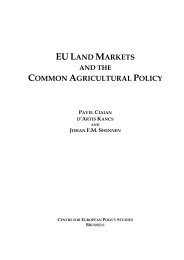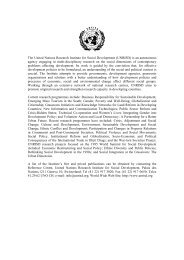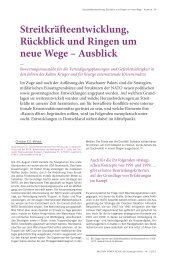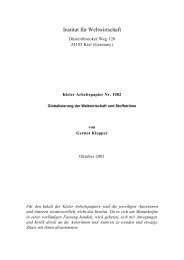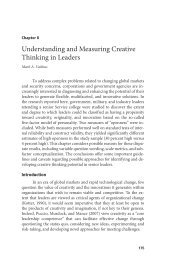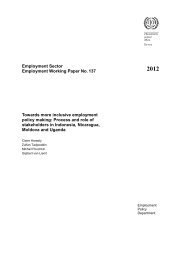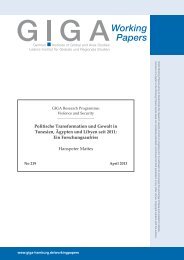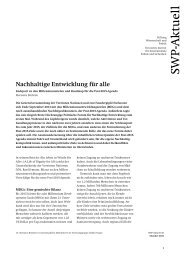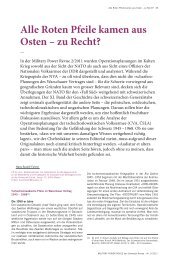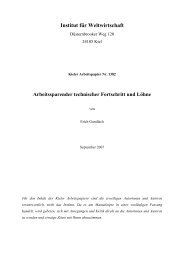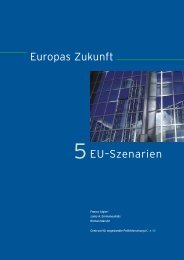The Nubian Sandstone Aquifer System
The Nubian Sandstone Aquifer System
The Nubian Sandstone Aquifer System
Create successful ePaper yourself
Turn your PDF publications into a flip-book with our unique Google optimized e-Paper software.
<strong>The</strong> <strong>Nubian</strong> <strong>Sandstone</strong> <strong>Aquifer</strong> <strong>System</strong> (NSAS)Contents1 Introduction 2372 Characteristics of the <strong>Nubian</strong> <strong>Sandstone</strong> <strong>Aquifer</strong><strong>System</strong> 2373 National groundwater use patterns 2423.1 Groundwater use patterns in Libya 2453.2 Groundwater use patterns in Egypt 2473.3 Groundwater use patterns in Chad 2483.4 Groundwater use patterns in Sudan 2484 Transboundary implications 2494.1 Pressures deriving from national use patterns 2504.2 Cooperation problems 2504.3 Need for cooperation 2515 Institutional arrangements for groundwatermanagement and transboundary cooperation 2525.1 National institutions 2535.1.1 Institutions in Egypt 2535.1.2 Institutions in Libya 2555.1.3 Institutions in Sudan 2565.1.4 Institutions in Chad 2585.2 Institutions for transboundary cooperation 2595.2.1 Cooperation over the NSAS 2595.2.2 Other agreements concerning transboundary waterresources in the region 264German Development Institute 235
Marianne Alker6 Prospects for transboundary cooperation, andrecommendation for German developmentcooperation 265Bibliography 271List of BoxesBox 1: <strong>The</strong> Great Man-Made River Project of Libya 246Box 2: Databases of the NSAS 262List of FiguresFigure 1: <strong>The</strong> <strong>Nubian</strong> <strong>Sandstone</strong> <strong>Aquifer</strong> and thePost-<strong>Nubian</strong> <strong>Aquifer</strong> 241List of TablesTable 1: Recoverable volumes and present extractionfrom the NSAS 244236 German Development Institute
<strong>The</strong> <strong>Nubian</strong> <strong>Sandstone</strong> <strong>Aquifer</strong> <strong>System</strong> (NSAS)Large-scale groundwater development projects are currently being carriedout in Libya and Egypt. Any assessment of the effects of these projectswill depend on estimates of the total amount of freshwater stored in theaquifer system and on assumptions concerning the interrelationships betweendifferent parts of the aquifer system. Scientists agree that the NSAShas been under unstable conditions since the beginning of economic developmentin Egypt and Libya (Gossel / Ebraheem / Wycisk 2004, 699). Itremains unclear what impact this will have. <strong>The</strong> University of Halle, Germany,is currently constructing models for calculating the impact ofEgyptian and Libyan groundwater development projects and is outliningdifferent management scenarios (Sefelnasr / Gossel / Wycisk 2007).Based on the more optimistic estimates of CEDARE, present extractionper year represents only 0.01 % of the estimated total recoverable freshwatervolume stored in the NSAS (Salem / Pallas 2002, 10; compare table 1).As discussed above, however, questions remain open about the reliabilityof these estimates.German Development Institute 243
Marianne AlkerTable 1: Recoverable volumes and present extraction from the NSAS<strong>Nubian</strong> <strong>Sandstone</strong><strong>Aquifer</strong>Post-<strong>Nubian</strong> <strong>Aquifer</strong>Area(km²)Volume instorage(km³)Area(km²)Volumein storage(km³)Volume of freshwaterin storage (km³) a Total recoverablegroundwatervolumeextractionfrom Post-NSAS(km³)(km³) b PresentPresentextractionfromNSAS(km³)Totalpresentextractionfrom NSAS(km³)Egypt 815,670 154,720 494,040 35,867 190,587 5,367 0.3060.200 0.506Libya 754,088 136,550 426,480 48,746 185,296 4,850 0.2640.567 0.831Chad 232,980 47,810 - - 47,810 1,630 - 0.000 0.000Sudan 373,100 33,880 - - 33,880 2,610 - 0.833 c 0.833TOTAL 2,175,838 372,960 920,520 84,613 457,573 14,457 0.570Source: Bakhbakhi (2006, 80)a Assuming a storativity of 10-4 for the confined part of the aquifer and a 7x10-2 for the unconfined part.b Assuming a maximum water decline of 100 m in the unconfined aquifer areas and 200 m in the confined aquifer areas.c Most of this water is extracted in the Nile <strong>Nubian</strong> Basin (833 ucm) which is not considered to be part of the <strong>Nubian</strong> Basin.1.600 2.170244German Development Institute
Marianne Alkerpiezometric 61 network of more than 150 wells has made it possible to developmathematical models on the basis of which future scenarios can beanalyzed (Salem 2007, 109).<strong>The</strong> FAO country profile indicates some negative developments for theshallow, non-renewable aquifers in the south of the country. Severe pollutionand a significant water table decline have been reported due to inadequatesanitation and excessive pumping (FAO 2005c).Box 1:<strong>The</strong> Great Man-Made River Project of Libya<strong>The</strong> primary objective of the GMRP is to achieve a secure supply of food and a stable supplyof water for domestic consumption. Libya’s most densely populated region in the north isinadequately supplied with water. <strong>The</strong> situation has worsened since saltwater intrusion followinga water table decline induced by over-pumping made water in the coastal aquifers unsuitablefor human consumption. <strong>The</strong> Great Manmade River Project is designed to transporteventually 2.3 BCM of fossil water from the south of Libya to the north.<strong>The</strong> project consists of five phases, of which Phases I and II are currently being implemented.In Phase I, two well fields in the As Sarir - Al Kufrah Basins of the NSAS havebeen selected as a source of 730 ucm of water per year to the coastal areas from Binghazito Sirt. <strong>The</strong> first well field is located in the Sarir area and currently produces 94 ucm ofwater per year. This is 25–30 % of its capacity. <strong>The</strong> second well field is located near thevillage of Tazirbu, some 200 km south of the Sarir well field, and is currently under development.In Phase II, several well fields in the Jabal Hasawna area will transport some 910ucm of water per year to the Jifarah plain around Tripoli.Altogether, the first wells already in operation produce about 140 ucm of water per year.<strong>The</strong> GMRP is designed mainly to serve irrigated agriculture, but up to now the water hasbeen used almost exclusively for domestic and industrial purposes in the major cities of thecountry.<strong>The</strong> total amount of water required to ensure basic food self-sufficiency and to meet thedomestic water requirements of the 12 million Libyans in the year 2025 is estimated torange between 10.5 and 16.4 bcm/year, compared to 4.3 bcm/year at present. When theGMRP is fully operational, and assuming that present groundwater production equipmentwill be in service until 2025, the total amount of water available for all uses will be approximately6.5 BCM/a and will thus barely cover 50 % of total water requirements (p. 5).According to the FAO, the GMRP will permit distribution of only 2.0 BCM/year (p. 9).Source: FAO (2005c)61 <strong>The</strong> piezometer is an instrument for measuring pressure changes in a material subjectedto hydrostatic pressure (Merriam-Websters 1998). A piezometric survey measuresgroundwater levels.246German Development Institute
<strong>The</strong> <strong>Nubian</strong> <strong>Sandstone</strong> <strong>Aquifer</strong> <strong>System</strong> (NSAS)3.2 Groundwater use patterns in EgyptEgypt’s water dependency ratio, which is defined as the percentage ofrenewable water resources originating outside the country, is at 97 %. <strong>The</strong>most important water source for Egypt is the Nile; Egypt meets only 7 %of its water demand from groundwater (Foster / Loucks 2006, 19). Of this,only 1.2 % 62 is fossil groundwater from the NSAS 63 (FAO 2005b). <strong>The</strong>FAO Aquastat country profile (2005) does not provide figures how thisamount is split among domestic, industrial and agricultural uses.Most of the groundwater presently extracted is used for agriculture. InEgypt, private farms located in the old traditional oases of the New Valley64 are the major users of water from the NSAS (Bakhbakhi 2006, 78).However, large irrigation schemes are under development in the southwesternpart of the country at Al Qweinat, in the vicinity of traditionalirrigation systems in the New Valley. In 2003 4,200 ha were already underirrigation, and it is planned to increase this area (Salem / Pallas 2002, 20;Salem 2007, 107; FAO 2005b). When fully developed, the New ValleyProject 65 will extract 540 MCM from the Dakhla sub-basin (Al-Eryani /Appelgren / Foster 2006, 32).Exploitation of groundwater has been growing in the last 40 years inEgypt, resulting in a groundwater table decline of 60 m in the oases. Allfree-flowing wells and springs have been replaced by deep wells(Bakhbakhi 2006, 78). 66Since the availability of water is a limiting factor for agricultural production,the use of saline groundwater for agriculture and the concomitant62 1.2 % is equivalent to 825 106m³/year (FAO 2005b).63 82 % of the groundwater used is seepage water extracted from the Nile Basin, 1.2 %comes from the NAS and 1.3 % is extracted from shallow aquifers in Sinai and on thenorthwest coast (FAO 2005b).64 <strong>The</strong> New Valley is a sequence of oases receiving water through discharge from theaquifer system. New Valley is also the name of the Egyptian governorate in this region.65 <strong>The</strong> New Valley Project has created a new river valley by pumping water from LakeNasser 310 km to the Paris Oasis. <strong>The</strong> water is used for agricultural production alongthe whole stretch (http://lexicorient.com/e.o/nw_valley.htm).66 Murakami (1995) gives figures according to which yields declined by 40 % after a fewdeep wells had been drilled in the 1950s in the Kharga and Daklha Oases.German Development Institute 247
Marianne Alkerchange in agricultural practices and crops is currently being discussed as apotential way to increase water supply (IWMI 2004). 673.3 Groundwater use patterns in Chad<strong>The</strong> northern part of Chad has a very dry climate and is only sparselypopulated (0.2 capita/km²; FAO Country Profile Chad). <strong>The</strong> figures publishedby the CEDARE do not indicate the amount of extraction from theNSAS on Chadian territory (Bakhbakhi 2006, 79), nor is the NSAS mentionedin the FAO Aquastat Country Profile Chad (2005a). Nevertheless, itcan be assumed that Chad is extracting water from the NSAS to such alimited extent that this is not monitored and is not thought to have anytransboundary implications. 68In general, future overexploitation of the NSAS by Chad seems unlikely,since groundwater requirements in the Sahara zone of Chad amount toonly 0.14 % of potential groundwater resources in that part of the country.By the year 2020 this figure is expected to rise to only 0.25 %, and it isestimated that the level of extraction from the NSAS will be only 0.07MCM/year in 2000. Moreover, groundwater use faces severe technical andeconomical constraints in Chad, and no irrigation projects are currentlyplanned (HCNE et al. 2003, 113, 66, 115).On the other hand, the Integrated Plan for Chad’s Water Development andManagement assesses conditions for the exploitation of groundwaterstored in the NSAS in Chad as favourable. However, information on thecharacteristics of groundwater use in the area of the NSAS is consideredinsufficient (HCNE et al. 2003, 111–112).3.4 Groundwater use patterns in Sudan<strong>The</strong> NSAS area in the north of Sudan receives an average annual rainfallof only 25 mm. As a consequence, the area is sparsely populated and is67 In Egypt, only 3 % of the country is under cultivation, and 97 % of all inhabitants livenear the Nile, resulting in a population density of 1,165 persons/km² in the Nile basin(FAO 2005b).68 This view is also shared by A. Sefelnsar from the University of Halle (personal communication4/2007).248German Development Institute
<strong>The</strong> <strong>Nubian</strong> <strong>Sandstone</strong> <strong>Aquifer</strong> <strong>System</strong> (NSAS)used by nomadic and semi-nomadic herders for extensive animal production.<strong>The</strong> FAO Aquastat country profile for Sudan (2005d) indicated thatgroundwater use is confined mainly to domestic purposes. Only 4 % of theirrigated area is supplied by groundwater, and this is probably notextracted from the NSAS, since the irrigated area is confined to thesouthern part of the country (FAO 2005d).Two groundwater basins, the Nile <strong>Nubian</strong> Basin and the Sahara <strong>Nubian</strong>Basin, are found in northern Sudan. Figures reported by CEDARE indicatethat Sudan extracts most of its groundwater from the Nile <strong>Nubian</strong> Basin,which is recharged by the Nile as well as by the underflow of the BlueNile (Omer 2002, 974). <strong>The</strong> Nile <strong>Nubian</strong> Basin is not considered to be partof the NSAS. Nevertheless, extraction from both the Nile <strong>Nubian</strong> Basinand the Sahara <strong>Nubian</strong> Basin are included in the figures by CEDARE. Noexplanation could be obtained why the abstraction figures from the NSASfor Sudan include both groundwater basins (compare table 1).Research by the University of Halle, Germany, has identified the Selimaoasis (probably in the Nile <strong>Nubian</strong> Basin) and the Naqiya oasis (probablywithin the Sahara <strong>Nubian</strong> Basin) as water-stressed areas. For this reason,Sudan’s groundwater development activities at these oases are included inthe University’s models of transboundary impacts in the NSAS (Sefelnasr /Gossel / Wycisk 2007). In summary, although Sudan is using and developingthe NSAS, it remains impossible at present to assess the extent of theseactivities and their transboundary impact, if any.4 Transboundary implications<strong>The</strong> following section discusses the transboundary impacts deriving fromnational groundwater use and provides an analysis of the cooperationproblem over the NSAS. In the process, the NSAS will be regarded as atransboundary resource with asymmetric use patterns in which upstreamdownstreamconstellations do not play a role. Two riparian countries,namely Egypt and Libya, are apparently exploiting the aquifer more intensivelythan the southern riparians Sudan and Chad. Although notransboundary impact of this between Egypt and Libya has been reported,negative impacts on Sudan are likely. No information is availableconcerning Chad in this regard.German Development Institute 249
Marianne Alker4.1 Pressures deriving from national use patternsAlthough extraction in relation to the volume stored in the NSAS might below, signs of over-extraction have been described. <strong>The</strong> Great Man-MadeRiver Project, for example, has led to reduced water levels in Libya´sKufra sub-basin and has dried up lakes linked to oases. Water levels alsodeclined in Egypt’s Kharga Oasis by 60 m from 1960 to 1998. In the north ofChad, groundwater level declines have led to a migration of the rural population(online: http://www-naweb.iaea.org/napc/ih/<strong>Nubian</strong>/IHS_<strong>Nubian</strong> _irrational_extraction.html).However, no information has been found to indicatethat this is a transboundary impact of Libya’s groundwater development.Population growth in the riparian countries is certain to increase waterdemand and will contribute further to already existing over-extraction ofgroundwater from the NSAS.4.2 Cooperation problems<strong>The</strong> types developed by Eckstein and Eckstein will be used here to developa conceptual understanding of the NSAS. <strong>The</strong>se six types were developedas paradigms for the application of international law to groundwateruse. <strong>The</strong> types show the potential transboundary implications ofgroundwater use in the hypothetical situation of two riparian countriessharing one aquifer (Eckstein / Eckstein 2005).<strong>The</strong> Eckstein-Eckstein types depict only situations involving two ripariancountries and thus do not perfectly reflect the situation of the NSAS withits four riparian countries. Nevertheless, type F (cf. page 25) can be appliedto the NSAS. As in this model, the NSAS is unrelated to any surfacewater bodies, is recharged only to a negligible extent, and thus containsmainly fossil water. Some characteristics of the NSAS are not contained inthe type: water in the NSAS is not stagnant but flows very slowly, andnatural discharge exists (see Chapter 2).Nevertheless, the transboundary implications shown in the type can alsobe applied to the NSAS since they are almost exclusively a function ofpumping.<strong>The</strong> assumption that transboundary implications are exclusively a functionof pumping is corroborated by Salem and Pallas, who describe the (ex-250German Development Institute
<strong>The</strong> <strong>Nubian</strong> <strong>Sandstone</strong> <strong>Aquifer</strong> <strong>System</strong> (NSAS)pected) negative transboundary impact on water quantity. Although theauthors do not expect mutual transboundary impacts to ensue fromdevelopment projects currently planned in Libya and Egypt, a negativeimpact on Sudan is considered possible. For example, intensified groundwaterpumping in the southeastern part of Egypt could cause a cone ofdepression extending 50–70 km beyond the Sudanese-Egyptian border(Salem / Pallas 2002, 20).This assumption is currently being tested in a research project by the Universityof Halle, Germany, which integrates the transboundary implicationsof major aquifer development projects in Egypt and Libya into modelsbased on current and planned extraction rates. While the results havenot yet been published, preliminary findings indicate that developmentprojects in the southeastern part of Egypt are likely to have a transboundaryimpact on the Kufra area (communication with A. Sefelnasr, Universityof Halle). Based on planned extraction rates, it is estimated that waterlevels will eventually sink below economically viable groundwater depths(Sefelnasr / Gossel / Wycisk 2007).Furthermore, increased groundwater pumping in the Siwa Oasis (Egypt)and the development of the well field in Libya’s Jaghubub will eventuallythreaten water quality due to the intrusion of salt water in the deeper, confinedpart of the NSAS (Salem / Pallas 2002, 10). It remains unclear, however,whether this projected decline in water quality will also affectneighbouring countries to the south.When studied in light of the Eckstein-Eckstein types (2005) and evidencefrom the region itself, the NSAS shows no upstream-downstream constellation.It can therefore be assumed that common interests and incentivesfor cooperation do indeed prevail. Nevertheless, development of the NSASseems to be asymmetrically distributed between Egypt and Libya, whichheavily exploit the NSAS on the one hand, and Sudan and Chad on theother. This may have a bearing on the incentives for cooperation amongthe riparian states.4.3 Need for cooperation<strong>The</strong> literature reflects different points of view concerning the need forcooperation. Al-Eryani / Appelgren / Foster (2006) have summarizedvarious assessments of the transboundary impact of water extraction andGerman Development Institute 251
Marianne Alkerthe resulting need for socio-political cooperation in using the NSAS.Given the rather long time frame (50–100 years) in which water willprobably continue to be available from the NSAS, the authors concludethat the most important objective in management of the NSAS is to optimizesocial developments induced by groundwater use. On this basis, theauthors underscore the need for socio-political cooperation among theriparian countries.Other authors already cited in the present study believe that the amounts ofwater needed even for the great development projects in Egypt and Libyaare so small in comparison to the stored volume that any future transboundaryimpact will be small (Khouri 1999, in: Al-Eryani / Appelgren /Foster 2006, 31–32). <strong>The</strong>se authors therefore see only a limited need forsocio-political cooperation in the form of regular data exchange (Attia1999, in: Al-Eryani / Appelgren / Foster 2006, 31–32). Others, on theother hand, emphasize the nature of the NSAS as a common pool resourceand point to the need for an integrative approach, taking the entire systeminto account, as opposed only to its parts, i.e. the sub-basins (Alghariani1999, in: Al-Eryani / Appelgren / Foster 2006, 31–32). This again pointsto a need for intensified cooperation among the riparian countries.In summary, socio-political cooperation through joint management of theNSAS appears necessary as a means of optimizing social development,since the riparians are very dependent on the NSAS and negative transboundaryimpacts cannot be ruled out. This is even more so inasmuch asdevelopment of the NSAS and its resulting, potentially negative transboundaryimpact are asymmetrically distributed between the northern andsouthern riparians. Cooperation is therefore needed to take this impact intoaccount, to manage it, and to harmonize the differing interests.5 Institutional arrangements for groundwatermanagement and transboundary cooperation<strong>The</strong> following is an overview of national water policies and national institutionalsetups for groundwater management in the NSAS area.Multilateral, bilateral and trilateral arrangements for transboundary cooperationconcerning the NSAS will be briefly described, and an analysiswill be given of achievements to date and challenges lying ahead for252German Development Institute
<strong>The</strong> <strong>Nubian</strong> <strong>Sandstone</strong> <strong>Aquifer</strong> <strong>System</strong> (NSAS)transboundary groundwater management through these institutional arrangements.5.1 National institutions5.1.1 Institutions in EgyptIn November 1999, Egypt created a department for the management offreshwater and non-fresh groundwater resources within the Ministry ofWater Resources and Irrigation (MWRI), thus delegating the responsibilityfor groundwater management clearly to a single agency. <strong>The</strong> departmenthas the following tasks:— Keeping track of present groundwater development and management— Conducting campaigns to increase public awareness of the need forgroundwater protection— Dealing with legislative aspects for the licensing of wells and pollutioncontrol— Investigating appropriate technologies for groundwater management,rain water harvesting. and the conservation of flash flood water— Finding ways to augment the supply of fresh groundwater (IWMI2004, 3).With the support of the German Development Cooperation agency (inGerman: GTZ), a “Vision and Strategy on Institutional Reform” has beendeveloped and agreed upon within the MWRI. Currently, a consultativeprocess with various ministries and with both regional and local representativesaims at a general agreement on this strategy for reform before it ispresented to the cabinet (online: http://www.gtz.de/en/ weltweit/maghrebnaher-osten/1477.htm).Groundwater in Egypt is owned by the nation and managed by the MWRI.As far as groundwater rights are concerned, two different systems coincidein Egypt. <strong>The</strong> licensing system, which ensures water rights relating towells, applies to most users in the country, including non-traditional usersin the desert. On the other hand, a system of traditional rules clearly allocatesownership of groundwater at oases and in wadis (IWMI 2004, 4).Irrigation schemes worked out by the NSAS will be subject to the licens-German Development Institute 253
Marianne Alkering system, whereas traditional agriculture at the oases will be governedby the traditional system.<strong>The</strong> MWRI has presented a Water Resources Policies and Strategies Plan(WRPSP) for the period from 1997 to 2017. This strategy aims at integratingall water-related ministerial policies and strategies (i.e. for agriculture,industry, domestic use etc.) into a single, comprehensive frameworkdocument. It provides for 5-year national plans. <strong>The</strong> WRPSP is aimed at(1) the management and development of existing resources in terms ofquantity, (2) control of all sources of pollution and serious hazards, and (3)the development of new water resources through close cooperation withthe upper riparian countries of the Nile Basin. 69 In Egypt, a nationalgroundwater monitoring system dating back to the 1960s exists to monitorgroundwater levels and to estimate potential and future recharge.Moreover, a system which uses data from 250 wells to monitor the qualityof groundwater has been in place since 1997. Apart from all this, wellinventories are updated every 3–5 years for licensing purposes (IWMI2004, 34).<strong>The</strong> Research Institute for Groundwater is the focal point of groundwatermanagement organization, and its director acts as national coordinator ofthe internationally supported Regional <strong>Nubian</strong> <strong>Sandstone</strong> <strong>Aquifer</strong> <strong>System</strong>Study Project (Abu Zeid s. a., 5).Available information indicates that Egypt has implemented a fairlyconsistent body of policies, legislation and strategies for managementplanning, monitoring, and assessment. However, the GTZ believes thatEgyptian water management structures are still so highly centralized thateffective fulfillment of their tasks is hindered.For the same reason, the GTZ also concludes that Egypt is struggling tocope with its water-related challenges. German-Egyptian cooperationtherefore seeks to promote further reforms in the Egyptian water sector inorder to achieve greater efficiency. Decentralisation, establishment ofregionally integrated water basin management, delegation of functions and69 A number of sophisticated tools such as models, databases, Geographic Information<strong>System</strong> (GIS) and Decision Support <strong>System</strong>s are already in use to provide input for theManagement Plan. Researchers from the National water Research Centre, in cooperationwith the Italian Centre for River Restoration, have developed a dynamic model forintegrated evaluation of management alternatives (Nardini / Fahmy 2005).254German Development Institute
<strong>The</strong> <strong>Nubian</strong> <strong>Sandstone</strong> <strong>Aquifer</strong> <strong>System</strong> (NSAS)authority to water use organisations, cost recovery from water users, andthe strengthening of ministerial authority in the exercise of regulatory andmonitoring functions are priority areas of such bilateral development cooperationwithin the Egyptian water sector (online: http://www.gtz.de/en/weltweit/maghreb-naher-osten/1477.htm).However, the available information does not yet permit a realistic assessmentof the actual state of groundwater governance in Egypt in terms ofuser participation and water-related governmental authority at decentralizedlevels.5.1.2 Institutions in LibyaIn Libya, the General Water Authority (GWA), established in 1972 isresponsible for all water resource assessment and monitoring. This institutionis organized into six General Directorates: Planning; Follow-up andStatistics; Water Resources; Dams, Irrigation and Drainage; Soils; andFinance and Administration. <strong>The</strong> GWA supervises all irrigation and drainageprojects in Libya and carries out research aimed at improving theirrigation network. It is also concerned with data storage and the developmentof water resources (e.g. linkups with GIS).<strong>The</strong> Secretariat of Agriculture and Animal Wealth is responsible for thedevelopment of irrigated agriculture and the implementation of majorirrigation projects. <strong>The</strong> Secretariat has appointed the General Water Authorityas the focal institution and its director as the national coordinator inLibya of the internationally supported Regional <strong>Nubian</strong> <strong>Sandstone</strong> <strong>Aquifer</strong><strong>System</strong> Study Project (Abu-Zeid s. a., 5).For the Great Man-Made River Project, a special authority, the “<strong>The</strong> GreatMan-Made River Water Utilization Authority”, was created, which issupervising the whole project up to final water use in irrigation. <strong>The</strong> Secretariatof Municipalities is responsible for water supply to urban settlements.In conclusion, the main characteristics of the institutional set up in Libyaare the relatively strong capacities for strategic planning and especiallyengineering in the country. User participation and decentralisation, however,are evidently not very much developed. At present, for example, noGerman Development Institute 255
Marianne Alkerwater fees are imposed on of irrigation water; rather, irrigated agricultureis subsidized, and water-saving practices are not politically encouraged.5.1.3 Institutions in SudanIn Sudan, the Ministry of Irrigation and Water Resources (MIWR) is thefederal body responsible for all water affairs. <strong>The</strong> Directorate of Groundwaterand Wadis is responsible for all groundwater issues as well as thoseconcerning non-nilotic streams and valleys. This Directorate is also thenational focal point for coordination of the internationally supported Regional<strong>Nubian</strong> <strong>Sandstone</strong> <strong>Aquifer</strong> <strong>System</strong> Study Project (Abu-Zeid s. a.,5).<strong>The</strong> responsibilities of the MIWR in Sudan are:— Planning, management, development, and allocation of water tovarious users throughout the country— International and regional cooperation concerning shared water resources— Planning, designing, executing, operating and maintaining the variousirrigation schemes— Control of water extraction— Construction of new irrigation works— Operation and maintenance of all large-scale irrigation structures anddrinking water facilities— Provision of means for hydropower generation and protection of thewater-related environment (FAO s. a.).Current groundwater legislation, however, assigns responsibilities to variousministries and government agencies with little integration of theirmandates. Moreover, water management institutions have been in a stateof flux for years (study by the IFPRI 2006, 30).According to the 1998 Constitution, all surface and subterranean resources,including water, are a public good whose utilization must be regulatedand managed by the Federal Government (IFPRI 2006, 20). Initially, thisregulation was introduced as part of the Water Resources Act of 1995.256German Development Institute
<strong>The</strong> <strong>Nubian</strong> <strong>Sandstone</strong> <strong>Aquifer</strong> <strong>System</strong> (NSAS)Sudan is a federal republic, and each of its states has its own state legislativeassembly, with complete administrative and fiscal autonomy (FAO s.a.). <strong>The</strong> State Water Corporation Act of 1996 regulated the management ofwater resources at the state level by de facto delegating responsibility tothe State Ministries of Engineering Affairs. In accordance with this Act,state water corporations were set up. <strong>The</strong>se entities are responsible forsetting policies, planning the use and development of water infrastructures,setting tariffs, and generally for all management initiatives concerninggroundwater. Despite the fact that no clear distinction is made betweenstate and interstate water, in practice the State Water Corporations’ jurisdictionalso extends to water inasmuch as it is formally regarded as nationalproperty (IFPRI 2006, 21).Other overlaps also exist and hinder effective water resources management.For example, the authority of the State Water Corporations oftenoverlaps with that of municipalities and provinces. Whereas the LocalGovernment Act of 2002 empowered municipalities to manage local waterresources, laws and agreements concerning the use and protection of localwater resources also exist at the regional level. Responsibilities are alsosometimes duplicated at the national level, e.g. between the Higher Councilfor Environmental and Natural Resources and the National Council forWater Resources (IFPRI 2006, 20–21). 70A new National Water Policy formulated in 2000 aims at improving watergovernance. However, this policy has not yet been implemented, with theresult that efficient coordination among the different agencies responsiblefor water management and greater involvement of the stakeholders are stillnot in place. Especially in the case of groundwater, local and state-levelagencies and bodies do not sufficiently consult with groundwater authoritiesand specialists in their decision-making processes. Moreover, groundwaterauthorities are not permitted to monitor drilling activities of thepetroleum industry or to enforce pertinent regulations.Although some policy and legislative steps have been taken on the federaland state levels, water governance and the water-related legislative frameworkremain on the whole weak in Sudan. Furthermore, existing legislationhas generally undermined or openly delegitimized the authority of70 <strong>The</strong> case study published by the IFPRI (2006) gives a very interesting analysis of naturalresource governance in Sudan.German Development Institute 257
Marianne Alkertraditional institutions for the management of natural resources and theresolution of conflicts over natural resources. Given the fact that the newinstitutions are weak, often overlap, and are not easily accessible to thelocal population, the regulatory gap created by the delegitimization oftraditional institutions can easily result in an escalation of use conflictsover natural resources within the country (IFPRI 2006, 21–22).5.1.4 Institutions in Chad<strong>The</strong> Ministry of Environment and Water in Chad is responsible forgroundwater resource planning. <strong>The</strong> Directorate of Hydraulics is responsiblefor hydrogeological issues and also provides data on available waterresources and water use for rural water supply and livestock. It is also theinstitution with primary responsibility for the Regional <strong>Nubian</strong> <strong>Sandstone</strong><strong>Aquifer</strong> <strong>System</strong> Study Project in Chad (Abu-Zeid s. a., 5). <strong>The</strong> GeneralDirectorate of Rural Works and Agricultural Hydraulics is in charge ofirrigation and drainage from surface and groundwater sources and agriculturalwater use in general (AHT Group for GTZ / LCBC 2006).A national Water Code has been in place in Chad since 1999, but is onlyweakly implemented. <strong>The</strong> Water Code defines all water resources in Chadas communal property, the exploitation of which is subject to declarationor authorisation under modern laws and must also comply with customarylaws (FAO 2005a; HCNE et al. 2003, 73–74). United Nations EnvironmentProgramme (UNEP) assesses the capacities and the legislativeframework for groundwater management in Chad as rather limited:equitable use of groundwater is not adequately governed by national law.Legal instruments and the authority to ensure compliance and enforceagreements are lacking (UNEP 2004). 71Moreover, the responsibilities of the different ministries are not clearlydefined; the jurisdictions of the ministries often overlap and are sometimesconflicting (UNEP / Fortnam / Oguntela 2004, 86, 94, 99). <strong>The</strong> situation inChad, one of the poorest countries in the world with a very low index ofhuman development, is further worsened by adverse conditions in the71 For more details on laws and regulations governing the water sector see HCNE et al.2003, 73–75.258German Development Institute
<strong>The</strong> <strong>Nubian</strong> <strong>Sandstone</strong> <strong>Aquifer</strong> <strong>System</strong> (NSAS)country such as domestic and cross-border armed conflicts (for example inthe Lake Chad region).Nevertheless, Chad drafted with support of United Nations Department ofEconomic and Social Affairs (UNDESA) and UNDP an Integrated Planfor Chad’s Water Development and Management in 2003. In order toorganize implementation and funding of the plan, institutional strengtheningof the Ministry of Water and a cooperation mechanism between thesupervising administration and stakeholders is needed. With the drafting ofthe Integrated Plan, an intersectoral consultative mechanism was set upand institutionalized in Chad for water governance (HCNE et al. 2003,151). As capacities for planning and implementation are assessed to be alimiting factor, a planning and monitoring unit has been set up in the Directorateof Hydraulics (HCNE et al. 2003, 151).<strong>The</strong> Integrated Plan covers groundwater-related activities for developmentof the <strong>Nubian</strong> <strong>Sandstone</strong> <strong>Aquifer</strong> (see chapter 4 for the Integrated Plan),namely the development of capacities and the sharing of know-how inrelation to the CEDARE project (see Chapter 5.2 below) (HCNE et al.2003, 198).5.2 Institutions for transboundary cooperation<strong>The</strong> chapter provides an overview of international institutions which havebeen established for transboundary groundwater management. Multilateralagreements are summarized, and the Joint Authority for the Study andDevelopment of the <strong>Nubian</strong> <strong>Sandstone</strong> <strong>Aquifer</strong> is analyzed in detail.5.2.1 Cooperation over the NSASAll riparian countries of the NSAS are members of the Joint Authority forthe Study and Development of the <strong>Nubian</strong> <strong>Sandstone</strong> <strong>Aquifer</strong>. 72 This JointAuthority was created by Libya and Egypt in 1982, and Sudan and Chadbecame members at a later point in time. <strong>The</strong> objectives and functions ofthe Commission have been declared as follows:72 Note: <strong>The</strong> term <strong>Nubian</strong> <strong>Sandstone</strong> <strong>Aquifer</strong> is equivalent to the term <strong>Nubian</strong> <strong>Aquifer</strong><strong>System</strong> used in this paper.German Development Institute 259
Marianne Alker— Collecting data, information and study results for classification,analysis and linkups— Conducting complementary studies to determine the present state ofthe aquifer regarding quality and quantity— Preparation of plans for the development of water resources as wellas proposing and implementing joint policies for the exploitation anduse of water resources at national and regional levels— Managing the aquifer on a sound scientific basis— Cooperation in the areas of training and capacity building— Awareness raising for rational use of the <strong>Nubian</strong> <strong>Sandstone</strong> <strong>Aquifer</strong>’swater— Studying the environmental impact of water development— Organizing scientific workshops, disseminating aquifer-related information,and strengthening ties to regional and international organizationswith common interests (Salem 2007, 111).<strong>The</strong> Authority’s board of directors consists of three members from eachmember country, an administrative secretariat, and a managing directorappointed by the board (Nanni et al. 2006, 55–56). <strong>The</strong> Authority ischaired by each member country on a rotational basis. <strong>The</strong> board membersare appointed from the Ministry of Water Resources and Irrigation inEgypt, the Secretariat of Agriculture of the Libyan Arab Jamahiriya, theMinistry of Irrigation and Water Resources in Sudan, and the Ministry ofEnvironment and Water in Chad (Abu-Zeid s. a., 3).Financial resources for the Authority are allocated annually. <strong>The</strong> budgetfor 2005 was 400,000 US$ (IAEA / UNDP / GEF 2006, 6.1), all of whichwas contributed by Libya (IAEA / UNDP / GEF 2006, 6.5). <strong>The</strong> boardshould meet twice a year and makes its decisions by a majority vote. However,only eight meetings have been held up to now, most of which weredevoted to an exchange of information and scientific data and a review ofwork in progress in the <strong>Nubian</strong> <strong>Sandstone</strong> <strong>Aquifer</strong> <strong>System</strong> Study Project.This project is a primary responsibility of the Joint Authority, and it remainsto be seen what role the Joint Authority will play in other projects inthe future (compare also IAEA / UNDP / GEF 2006, 6.5).<strong>The</strong> first phase of the <strong>Nubian</strong> <strong>Sandstone</strong> <strong>Aquifer</strong> <strong>System</strong> Study Projectstarted in 1994. <strong>The</strong> project is carried out by CEDARE. This first phase260German Development Institute
<strong>The</strong> <strong>Nubian</strong> <strong>Sandstone</strong> <strong>Aquifer</strong> <strong>System</strong> (NSAS)was financed by the International Fund for Agricultural Development(IFAD), the second by the Islamic Development Bank (Salem 2007, 112;Abu-Zeid s. a., 2).<strong>The</strong> project has two main objectives: 1) formulation of a regional strategyfor utilizing of the NSAS, and 2) developing the capacity of national institutionsto monitor and manage groundwater reserves in the riparian countries(WWC 2006, 76). 73Concerning the first objective, three major steps have been taken so far.First, the Joint Authority has sought to establish an adequate institutionalsetup for the formulation of a regional strategy. In line with this, the JointAuthority for Study and Development already mentioned above was revitalizedand expanded to include Chad (in 1999), and other supportiveregional and national institutions were also created. 74Secondly, studies to provide accurate technical information about theNSAS were carried out. <strong>The</strong>se included the acquisition of data on ca.2,100 wells, a GIS system with regional, hydro-geological and water qualitymaps, a mathematical model, simulation of different scenarios of exploitation,draft agreements by the National Coordinators on a protocol forinformation-sharing, and development of a website (WWC 2006, 76, comparealso FAO s. a.). All information thus gained is stored in the <strong>Nubian</strong><strong>Aquifer</strong> Regional Information <strong>System</strong> (NARIS) (see box 2).73 In CEDARE (s. a.) a third objective was cited for the first project phase: “Assist therural poor in accessing the resources needed to better their lives” (s. a., 5). Other publicationsdo not refer explicitly to this objective. <strong>The</strong> socio-economic study describedabove might well be included under this objective.74 A Regional Program Steering Committee 30 was also formed by the members of theJoint Authority to manage its work plan and budget (WWC 2006, 76). Another bodyformed was the Regional Technical Review Committee, consisting of representativesfrom Egypt, Libya, Sudan, Chad, CEDARE, IFAD, IDB, UNESCO, ACSAD, OSS, andthe Technical University of Berlin (Abu-Zeid s. a., 5). With support from the Project,national focal point institutions were appointed in the member countries, and offices ofthe Joint Authority were opened in each country (Abu-Zeid s. a., 5, 2).German Development Institute 261
Marianne AlkerBox 2:Databases of the NSAS<strong>The</strong> <strong>Nubian</strong> <strong>Aquifer</strong> Regional Information <strong>System</strong> (NARIS) contains data on water locationcharacteristics, groundwater levels, water quality, water extraction, and stratigraphicand hydraulic parameters. Additionally, it includes a bibliographic database on earlierstudies and research findings. It is linked to a geographical information system. NARIS isused to prepare input parameters for aquifer models as a means of simulating scenarios fordifferent approaches to development of the NSAS.NARIS is stored on a server operated by CEDARE in Egypt. This server is accessible onlyto members of the Joint Authority. However, the application and maintenance of NARIS isalso subject to severe limitations: difficulties in renewing software licences in Sudan andEgypt and technical limitations in Chad. Furthermore, the IAEA / UNDP / GEF project hasidentified major gaps in NARIS.A second NSAS database is the Isotope Hydrology Information <strong>System</strong> (ISOHIS), whichfocuses on isotopes and related data. It is operated by the IAEA. However, this databasetoo appears to have significant gaps. One of the first meetings of the project partners of thenew IAEA / UNDP / GEF <strong>Nubian</strong> Project recommended that close links be establishedbetween ISOHIS and NARIS in order to make them compatible and more accessible to theriparian countries and other institutions.Source: Abu-Zeid s. a., 6 / Grossmann (2006, 211–212); IAEA / UNDP / GEF (20066.0); IAEA / UNEP / GEF (2007, 33)A third objective concerns socio-economic development in the region as awhole. Recommendations for future socio-economic development wereelaborated, and a system of regional indicators was developed in order tobalance the groundwater needs of the population and available groundwaterresources on the basis of a comprehensive assessment (WWC 2006,76). This was carried out in the second phase of the project up to 2002(Abu-Zeid s. a., 2). Abu-Zeid, who has described decisive factors forsocio-economic development in the NSAS in detail, has shown that thetopics relevant for cooperation concerning the NSAS go beyond hydrogeologicaland technical aspects. However, it remains unclear whether andhow these issues are being taken into consideration in national policies andcooperation concerning use and development of the NSAS, since detailedinformation from the concerned member states is lacking.With respect to the second objective mentioned above, namely the developmentof technical capacities, an assessment of needs has been carriedout, hardware and software have been purchased, and training courses in262German Development Institute
<strong>The</strong> <strong>Nubian</strong> <strong>Sandstone</strong> <strong>Aquifer</strong> <strong>System</strong> (NSAS)key areas have been carried out by the national institutions in the fourriparian countries (WWC 2006, 76). 75<strong>The</strong> member parties of the Joint Authority signed two agreements in 2000:<strong>The</strong> first governs the supervision and exchange of groundwater informationconcerning the NSAS. <strong>The</strong> members agreed to continue studying theNSAS, to share information gained by regional projects, and to incorporatethis into a regional information system (details below). <strong>The</strong> second agreementgoverns continuous monitoring of the aquifer and data sharing byupdating the regional information system. 76 <strong>The</strong>se two agreements establisha continuous mechanism of regional cooperation (Abu-Zeid s. a., 2, 8).As this makes clear, the Joint Authority is primarily an investigation andinformation exchange group which is not actually in charge of managementdecisions. However, its objectives include joint groundwater management,and its modelling activities do provide information for decisionmakers.<strong>The</strong> major challenge ahead for the Joint Authority (JA) will be to promotea transition from transboundary cooperation in information sharing to jointmanagement. Recently, A “<strong>Nubian</strong> Project” was started with this as itsgoal. Partners in the project include UNDP / GEF / International AtomicEnergy Agency (IAEA), United Nations Educational, Scientific and CulturalOrganization (UNESCO), the Joint Authority itself, and the four NSAScountries. <strong>The</strong> project’s long-term goal is to establish a rational and equitablesystem of management of the NSAS for sustainable socio-economicdevelopment and the protection of biodiversity and land resources. <strong>The</strong>project’s four immediate objectives are: 1) to identify priority transboundarythreats and root causes; 2) to fill key gaps; 3) to prepare a StrategicAction Programme (SAP); and 4) to establish a framework for SAPimplementation (online: http://www-naweb.iaea.org/ napc/ih/<strong>Nubian</strong>/IHS_nubian.html).75 Training was given in the application of mathematical models, the use of databases, theGIS, and the use of advanced monitoring equipment (Salem 2007, 112).76 It is planned to provide updates of the Regional Information <strong>System</strong> in a database whichis accessible through the Internet. This, however, has not yet implemented due to a lackof funds (Abu-Zeid s.a., 8).German Development Institute 263
Marianne Alker5.2.2 Other agreements concerning transboundary waterresources in the regionApart from cooperation regarding the NSAS as a whole, the two NSASriparian countries of Egypt and Sudan also cooperate in the Nile BasinInitiative, which has distinct objectives of its own and an individual regionalscope.<strong>The</strong> Nile Waters Agreement, signed between Egypt and Sudan in 1959,established regulations for each country’s share of the Nile. Joint transboundaryNile management received new impulses during the 1990s,especially in 1998, when all riparian countries of the Nile, namely Tanzania,Burundi, Rwanda, Democratic Republic of the Congo (DRC),Uganda, Kenya, Ethiopia and Eritrea (the latter with observer status only)created a “Regional Partnership for Sustainable Development and Managementof the Nile Waters”. On the basis of this Partnership, the NileBasin Initiative (NBI) was launched in 1999. <strong>The</strong> objective of the NBI is“to achieve sustainable socio-economic development through the equitableutilization of and benefit from the common Nile Basin water resources”(FAO 2005b). A strategic program containing a number of joint projectswas developed within the NBI (Grossmann 2006, 207).In contrast to practices concerning the NSAS, information sharing andsteps towards joint management of the Nile appear to be hampered bylimited political will due to strategic reasons in this upstream-downstreamconstellations (Grossmann 2006, 207). In particular, problems seem toappear between Sudan and Egypt.It may therefore be asked whether the agreements reached above all betweenSudan and Egypt concerning the use of the Nile have an influenceon their negotiations concerning the use of the NSAS and vice versa. Twobasic facts have to be kept in mind: First, Sudan is in the upstream positionof the Nile and second, groundwater development projects in Egypt nearthe border with Sudan are likely to have a negative impact on groundwateravailability in Sudan. For these reasons it can be assumed that any evaluationof water cooperation between Egypt and Sudan must take both NBIand NSAS cooperation into account.In general terms, the respective responsibilities of the NBI and the JointAuthority, along with their respective memberships, coincide only in certainareas. However, inasmuch as both organizations are of great impor-264German Development Institute
<strong>The</strong> <strong>Nubian</strong> <strong>Sandstone</strong> <strong>Aquifer</strong> <strong>System</strong> (NSAS)tance for water policy and security in their riparian countries, both couldalmost certainly benefit from the experience gained by countries which aremembers of each.In addition to the NBI, other institutions also exist for transboundary watercooperation in the region. Libya, for example, also cooperates with Tunisiaand Algeria over the North-West Sahara <strong>Aquifer</strong>. Chad is a membercountry of the Lake Chad Basin Commission. 776 Prospects for transboundary cooperation, andrecommendation for German developmentcooperationAccess to information and conclusions<strong>The</strong> present study is based on the available literature and on communicationwith experts from the BGR and the University of Halle, Germany.Attempts to obtain the assistance of representatives from CEDARE wereunsuccessful.Although, information on the NSAS was accessible from the literature,recent detailed information on transboundary implications was not available.<strong>The</strong> available data show high variability and could therefore lead todiffering conclusion.<strong>The</strong> new IAEA / UNDP / GEF Project currently being conducted by theriparian countries is aimed at identifying and filling these data gaps. Duringthe project’s Technical Meeting held in Vienna in April 2007, abaseline of technical knowledge concerning the NSAS was established(IAEA / UNDP / GEF 2007) on the basis of which a TransboundaryDiagnostics Analysis will be undertaken. <strong>The</strong> technical information gainedin this way will serve as a basis for negotiations on transboundarygroundwater management.77 Transboundary groundwater management for the Lake Chad Basin and the North-WestSaharan <strong>Aquifer</strong> are discussed elsewhere in this volume in two separate case studies.German Development Institute 265
Marianne AlkerTransboundary impacts and conclusions for transboundarycooperationSince estimates of groundwater quantities stored in the aquifer system andtheoretically available for use vary substantially, different authors havepresented different conclusions regarding current and planed groundwaterdevelopment projects in the region. Briefly, it appears that Egypt’sgroundwater development projects are likely to have a negative impact onSudan. Whether this will also be the case for Libya is still subject to investigation.A drop in the level of groundwater tables at centres of extractionin Libya and Egypt has been reported.<strong>The</strong> main impetus for cooperation over the use of the NSAS derives fromprevailing common interests and similar incentives among the riparianstates. This was underlined above by an analysis of the Eckstein-Ecksteintypes, which showed that the NSAS is a common pool resource withoutconsiderable upstream-downstream constellations.In general, cooperation concerning the use of the NSAS is a strategicchoice for the riparian countries in order to prevent international conflictsover socio-economic and environmental objectives and to secure access towater. This is naturally of enormous importance in this waterscarce region.Thus, cooperation in the use of the NSAS can be described as an issue ofnational security.While the incentives for cooperation are similar, they are not equallystrong for each riparian state: in each case, the capacity to pursue nationalinterests differs substantially in practice depending on economic and politicalpower and stability. This results in asymmetrical use and developmentof the NSAS. Among the riparian countries, Chad and Sudan seem tobe in a weaker negotiating position since their groundwater extraction islimited by both technical and economic factors as well as by politicalstability.<strong>The</strong> riparian countries have created a promising institutional environmentfor mutual cooperation in use of the NSAS. <strong>The</strong>y have institutionalizedthis cooperation through the Joint Authority and other related interriparianand national organizational bodies. This process has been stronglysupported by the CEDARE / IFAD / IDB project. Since the NSAS is oneof ten transboundary water basins selected by African Ministers’ Council266German Development Institute
<strong>The</strong> <strong>Nubian</strong> <strong>Sandstone</strong> <strong>Aquifer</strong> <strong>System</strong> (NSAS)on Water (AMCOW) within the framework of New Partnership for Africa’sDevelopment (NEPAD) to receive support from the African WaterFacility, further activities in joint monitoring and evaluation as well asstrategic development can be expected.Main aspects of the interriparian cooperation at the moment are investigation,joint modeling and information sharing. In this regard, the majorchallenge appears to lie in improving the interface between monitoring anddecision-making in order to react to changes within the system and toarrive at decisions based on reliable monitoring results. Analysis showsthat the topics discussed among the riparian countries go beyond hydrogeologicaland technical issues to include the socio-economic dimensionsof groundwater use in the region. 78 This provides a clue to the possibledirection of future development of the institutions for cooperation in use ofthe NSAS, i.e. from data-sharing to joint management. However, the extentto which these issues are actually reflected in national policy makingand in the cooperation process can at this stage not be fully assessed.Barriers for undertaking further steps towards joint management by delegatingmore power to the Joint Authority can, however, be assumed toexist. Since access to the NSAS is a matter of national security, especiallyfor Egypt and Libya, decisions concerning groundwater developmentprojects are politically highly sensitive. This may not only create incentivesfor cooperation but also hinder them: that is, the countries involvedmay well refrain from transferring this kind of decision to an institution fortransboundary cooperation.<strong>The</strong> Joint Authority is an important part of Africa’s institutional architecturefor transboundary water management. While it may not yet have theauthority to implement management decisions, it remains a successfulforum for information collection and exchange.Since transboundary cooperation concerning groundwater resources in theregion is still in its infancy compared to cooperative use of surface waterresources, the endeavours of Egypt, Chad, Sudan and Libya to jointlyagree on the use of transboundary non-renewable groundwater may well78 Given the fact that Chad and Sudan in particular are economically underdevelopedcountries, the socioeconomic impact of groundwater development may be important forthe reduction of rural poverty there.German Development Institute 267
Marianne Alkeryield an example of good practices for other countries. <strong>The</strong> challengeahead is to move from developing the information sharing to cooperationin the form of joint management. This, in fact, is the goal of the recentlyinitiated “<strong>Nubian</strong> Project”.External actors and recommendations for Germandevelopment cooperationConcerning the potential for cooperation between the NBI and the JointAuthority and its subordinate bodies, it is important to remember that theNBI and the Joint Authority are two separate institutions whoseresponsibilities are not identical. <strong>The</strong> importance of studying both thereforelies more in lessons to be learned regarding bilateral cooperation betweenSudan and Egypt in both areas in spite of their different objectives.External development support has played an important role in reviving thecooperation process in 1998 and technically and financially promoting it.In addition, research seems to be playing an increasingly important role forinformation gathering and the creation of models of use of the NSAS.<strong>The</strong> following considerations can be derived from the preceding analysisfor German development cooperation:Most importantly, a general decision needs to be made as to whetherGerman development cooperation should actively support the developmentof non-renewable groundwater resources. <strong>The</strong> current BMZ SectorConcept for Water states that support for deriving drinking water fromnon-renewable groundwater resources should be considered only if a)there is no other water source available to meet the demand for drinkingwater, and b) if a highly significant positive development impact can beexpected from such intervention. It is indispensable, however, that allalternatives be carefully evaluated as a means of improving the waterbalance in the long run. 7979 See BMZ (2006, 17): “In water catchment areas with a strained or negative waterbalance, the drinking water supply can only be safeguarded – if no water is to be divertedaway from agriculture – through the temporary or permanent overexploitation ofgroundwater or from rivers and, in extreme cases, the utilisation of fossil groundwater.in such situations, the need to ensure a basic supply of water services to poor populationgroups must be brought into line with the need for environmental sustainability. in268German Development Institute
<strong>The</strong> <strong>Nubian</strong> <strong>Sandstone</strong> <strong>Aquifer</strong> <strong>System</strong> (NSAS)Applying this framework to the case of the NSAS, the following conclusionscan be drawn:— In actual fact, the population depends completely on the NSAS for itswater supply, since no alternative water sources are available. Supportfor the drinking water supply should therefore be an option forGerman development cooperation within the framework of the WaterSector Concept. However, any measure must focus on improving thedrinking water supply of marginalized people.— Egypt and Libya are using the NSAS to augment irrigated agriculturein the Sahara Desert. Support for these activities would not conformto the Water Sector Concept. Nevertheless, support for greater wateruse efficiency and for the introduction (or further development) ofwater-saving practices (like wastewater use in agriculture) could bean interesting option for German development cooperation.Apart from implications involving the non-renewable nature of groundwaterresources in the region, the dimension of conflict prevention mustalso be taken into account. For this reason, support for the establishment ofinstitutions and for the development of strategies in the riparian countriesfor successful cooperation in use of the NSAS could well be considered asa potential area of support for German development cooperation.In this regard, German development cooperation may have effective entrypoints at both the national and regional levels.<strong>The</strong> national level: since the riparian countries are relatively advancedregarding their information-sharing mechanisms, the focus could be put ondeveloping national capacities for groundwater management. This is especiallytrue in the case of Chad and Sudan, which appear considerably lessadvanced in terms of capacities for groundwater management in comparisonto Libya and Egypt. However, since only Egypt is currently a partnercountry for bilateral German development cooperation, options at thenational level are at the moment limited to this country.In response to its tremendous population growth, Egypt is currently attemptingto develop other parts of the country for agricultural productionand human settlement. Here, the NSAS’s non-renewable groundwaterthe long term, social justice can only be achieved on the basis of ecologically sustainableresource management.”German Development Institute 269
Marianne Alkerplays a rather small role in comparison to that of the River Nile. Consequently,it would appear far more important for the reduction of (rural)poverty in Egypt to provide support for improving water governance ingeneral and for increasing the efficiency of agricultural production whilemaking the best use of available water resources. For these reasons itseems advisable that German development cooperation should concentrateon these issues in its development cooperation with Egypt rather than onbilateral support in relation to the NSAS.<strong>The</strong> regional level: the Joint Authority and its subordinate bodies couldprovide institutional entrypoints for providing advisory services. <strong>The</strong> creationof mechanisms for resolving conflicts and compensating for negativeimpacts seems to be an important starting point in this regard. However,the riparian countries’ political will to introduce such steps remains difficultto assess.Information from the new IAEA / UNDP / GEF project, however, hasshown that the Joint Authority is perceived by some of the riparians asbeing an institutional body of the IFAD project rather than an independentregional institution. <strong>The</strong> possibility of channelling support through theJoint Authority will therefore depend in future on strengthening the authorityof existing institutions, on building up technical capacities, and onimproved dialogue on the national and regional (= Joint Authority) levelsin order to eventually change the role of this institution and the riparianscountries’ perception of it.Germany is already contributing support at the regional level through itsmultilateral development cooperation. In view of the facts already presented,the present study recommends that these activities continue toreceive support.Finally, and again on the regional level, German development cooperationshould intensify its cooperation with the African Water Facility for transboundarywater management (AMCOW), since the NSAS is one of thepriority areas for AMCOW. Support for AMCOW could therefore beextended to the improvement of capacities for implementing activitiesalready planned for the NSAS.270German Development Institute
<strong>The</strong> <strong>Nubian</strong> <strong>Sandstone</strong> <strong>Aquifer</strong> <strong>System</strong> (NSAS)BibliographyAbu-Zeid, K. M. (s. a.): Regional Management of the <strong>Nubian</strong> <strong>Sandstone</strong> <strong>Aquifer</strong>.Potential Arab Region & Latin America Cooperation on Large <strong>Aquifer</strong>s;online: http://www2.mre.gov.br/aspa/semiarido/data/Palestr%20Khaled%20Abu-Zeid.docAfrican Water Facility Council (2005): Operational Programme for 2005–2009;online: http://www.amcow.org/initiatives.phpAHT Group for GTZ / LCBC (Lake Chad Basin Commisison) (2006): LCBCWorkshop on Data Exchange Agreements, Deliberations of Workshop heldin Maroua, Cameroon on 6–8 June 2006, unpublished documentAl-Eryani, M. / B. Appelgren / S. Foster (2006): Social and economic dimensionsof non-renewable resources, in: S. Foster / D. P. Loucks (eds.), NonrenewableGroundwater Resources: A Guidebook on Socially SustainableManagement for Water-Policy Makers, Paris: United Nations Educational,Scientific and Cultural Organization (IHP-VI series on groundwater 10), 25–34Ambroggi, R. P. (1966): Water under Sahara, in: Scientific American 214/5, 21–49Bakhbakhi, M. (2006): <strong>Nubian</strong> <strong>Sandstone</strong> <strong>Aquifer</strong> <strong>System</strong>, in: S. Foster / D. P.Loucks (eds.), Non-renewable Groundwater Resources: A Guidebook on SociallySustainable Management for Water-Policy Makers, Paris: United NationsEducational, Scientific and Cultural Organization (IHP-VI series ongroundwater 10), 75–81BMZ (Bundesministerium für wirtschaftliche Zusammenarbeit und Entwicklung)(2006): Water Sector Strategy: Strategies 152 Bonn; online: http://www.bmz.de/en/service/infothek/fach/ konzepte/konzept152.pdfCEDARE (s. a.): Report: Centre for Environment and Development for <strong>The</strong> ArabRegion and Europe (CEDARE) on Activities to Support African CountryParties under UNCCD, CairoEckstein, Y. / G. Eckstein (2005): Transboundary <strong>Aquifer</strong>s: Conceptual model fordevelopment of international law, in: Ground Water 43 (5), 679–90FAO (United Nations Food and Agriculture Organization) (2005a): AquastatCountry Profile Chad; online: http://www.fao.org/ag/agl/aglw/aquastat/countries/chad/index.stm– (2005b): Aquastat Country Profile Egypt; online: http://www.fao.org/ag/agl/aglw/aquastat/countries/egypt/index.stm– (2005c): Aquastat Country Profile Libya; online: http://www.fao.org/ag/agl/aglw/aquastat/countries/libya/index.stm– (2005d): Aquastat Country Profile Sudan; online: http://www.fao.org/ag/agl/aglw/ aquastat/countries/sudan/index.stmGerman Development Institute 271
Marianne Alker– (s. a.): Groundwater Agreements; online: http://www.fao.org/docrep/008/y5739e/y5739e05.htmFoster, S. / D. P. Loucks (eds.) (2006): Non-renewable groundwater resources: AGuidebook for socially-sustainable management for water policy makers,Paris: United Nations Educational, Scientific and Cultural Organization (IHP-VI Series on Groundwater 10)Gossel, W. / A. M. Ebraheem / P. Wycisk (2004): A very large scale GIS-basedgroundwater flow model for the <strong>Nubian</strong> sandstone aquifer in Eastern Sahara(Egypt, northern Sudan and eastern Libya), in: Hydrogeology Journal 12,698–713Grossmann, M. (2006): Cooperation on Africa’s international waterbodies: informationneeds and the role of information sharing, in: W. Scheumann / S.Neubert (eds.), Transboundary Water Management in Africa, (Study 21)Bonn: Deutsches Institut für Entwicklungspolitik, 173–235HCNC et al. (2003): Integrated Plan for Chad’s Water Development and Management,Main DocumentIAEA (International Atomic Energy Agency) / UNDP (United Nations DevelopmentProgramme) / GEF (Global Environment Facility) (2007): TechnicalBaseline Meeting Report: <strong>Nubian</strong> <strong>Sandstone</strong> <strong>Aquifer</strong> <strong>System</strong> Medium SizedProject; May 8–12, Vienna, Austria; online: http://www-naweb.iaea.org/napc/ih/<strong>Nubian</strong>/document/Final %20Report %20RAF8036 %20TBM %20held%20on %20May %202006.pdf– / – / – (2006): Inception Meeting Report: <strong>Nubian</strong> <strong>Sandstone</strong> <strong>Aquifer</strong> <strong>System</strong>Medium Sized Project November, Tripoli, Libya; online: http://wwwnaweb.iaea.org/napc/ih/<strong>Nubian</strong>/document/<strong>Nubian</strong>%20inception_report%20-may1107.pdfIFPRI (International Food Policy Research Institute) (2006): Empowering theRural Poor under Volatile Policy Environments in the Near East and NorthAfrica Region Research Project: Sudan Case Study; online: http://www.ifad.org/events/nrp/case/sudan.pdfIWMI (International Water Management Institute) (2004): Harnessing Salty WaterTo Enhance Sustainable Livelihoods of the Rural Poor in Egypt. Second draftcountry report for the research project Harnessing Salty Water to EnhanceSustainable Livelihoods of the Rural Poor in Four Countries in West Asiaand North Africa: Egypt, Jordan, Syria and Tunisia; online: http://www.iwmi.cgiar.org/Assessment/files_new/research_projects/ICBA %20NationalReport_Egypt.pdfMerriam-Webster (1998): Collegiate Dictionary 10th edition, Merriam-WebsterInc., Spingfield, Mass.272German Development Institute
<strong>The</strong> <strong>Nubian</strong> <strong>Sandstone</strong> <strong>Aquifer</strong> <strong>System</strong> (NSAS)Murakami, M. (1995): Managing Water for Peace in the Middle East: AlternativeStrategies, <strong>The</strong> United Nations University, Tokyo, Japan; online: http://www.unu.edu/unupress/unupbooks/ 80858e/80858E00.htm# ContentsNanni, M. et al. (2006): Legal and Institutional Considerations, in: S. Foster / D. P.Loucks (eds.), Non-renewable Groundwater Resources: A Guidebook on SociallySustainable Management for Water-Policy Makers Paris: United NationsEducational, Scientific and Cultural Organization (IHP-VI series ongroundwater 10), 49–57Nardini, A. / H. Fahmy (2005): Integrated Evaluation of Egpyt’s Water ResourcesPlans: A Framework to Cope with Sustainablity, in: Water International 30(3), 314–28Omer, A. M. (2002): Focus on groundwater in Sudan, in: Environmental Geology41, 972–76Puri, S. (ed.) (2001): Internationally Shared (Transboundary) <strong>Aquifer</strong> ResourcesManagement: <strong>The</strong>ir significance and sustainable management Paris: UnitedNations Educational, Scientific and Cultural Organization (IHP-VI, IHP NonSerial Publications in Hydrology)Salem, O. (2007): Management of Shared Groundwater Basins in Libya, in: AfricanWater Journal 1 (1); online: http://www.uneca.org/awich/ AWJ_Vol1_No1Salem, O. / P. Pallas (2002): <strong>The</strong> <strong>Nubian</strong> <strong>Sandstone</strong> <strong>Aquifer</strong> <strong>System</strong> (NSAS) in:B. Applegren (ed.), Managing Shared <strong>Aquifer</strong> Resources in Africa Paris: U-nited Nations Educational, Scientific and Cultural Organization (IHP-VI Serieson groundwater 8), 19–21– (2001): <strong>The</strong> <strong>Nubian</strong> <strong>Sandstone</strong> <strong>Aquifer</strong> <strong>System</strong> (NSAS), in: S. Puri (ed.), InternationallyShared (Transboundary) <strong>Aquifer</strong> Resources Management: <strong>The</strong>ir significanceand sustainable management Paris: United Nations Educational,Scientific and Cultural Organization (IHP-VI, IHP Non Serial Publications inHydrology), 41–44Sefelnasr, A. / W. Gossel / W. Wycisk (2007): GIS-based groundwater flow modellingof the <strong>Nubian</strong> <strong>Aquifer</strong> <strong>System</strong>, Western Desert Egypt, Poster, Halle:University HalleUNEP (United Nations Environment Programme) / M. P. Fortnam / J. A. Oguntola(eds.) (2004): Lake Chad Basin, (GIWA Regional assessment 43) Kalmar,Sweden: Kalmar UniversityWWC (World Water Council) (2006): 4th World Water Forum, African RegionalDocument Water Resources Development in Africa, Mexico City, Mexico, 75–6Zektser, I. S. / L. G. Everett (eds.) (2004): Groundwater Resources of the Worldand their Use Paris: United Nations Educational, Scientific and Cultural Organization(IHP-VI, Series on Groundwater 6)German Development Institute 273



